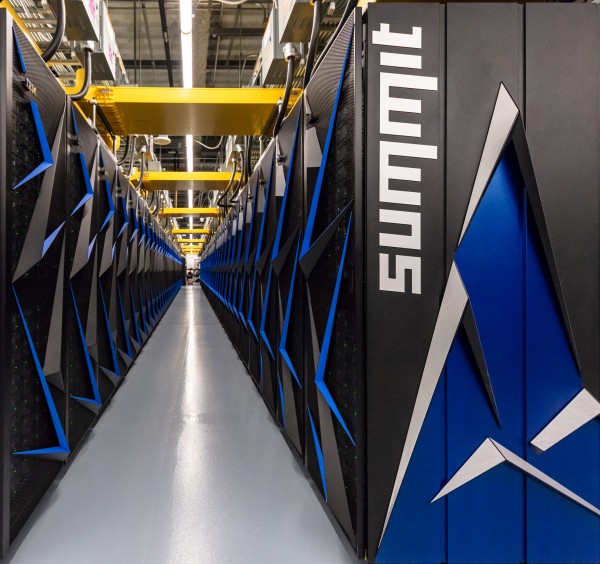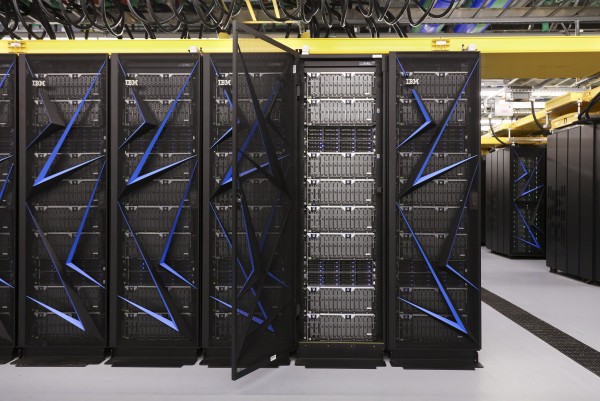
Oak Ridge National Laboratory’s Summit supercomputer was again named number one on the TOP500 List, a semiannual ranking of the world’s fastest computing systems on Monday, Nov. 12, 2018. (Photo credit: Carlos Jones/Oak Ridge National Laboratory, U.S. Department of Energy)
The 200-petaflop Summit supercomputer at Oak Ridge National Laboratory stayed at number one on the semiannual TOP500 list of the world’s most powerful supercomputers released Monday.
The Sierra supercomputer at Lawrence Livermore National Laboratory in Livermore, California, climbed to number two from number three. That means the United States now has the top two systems in the world, a position that China held a year ago.
Summit, a water-cooled IBM-built supercomputer, debuted at number one on the TOP500 list in June. That was the first time since 2012 that the United States had the most powerful supercomputer in the world. The earlier top system, Titan, a Cray machine, is also located at ONRL. ORNL and LLNL are both U.S. Department of Energy laboratories.
Officials celebrated the launch of Summit in a ceremony attended by U.S. Energy Secretary Rick Perry on June 8. The supercomputer is capable of 200 petaflops, or 200,000 trillion calculations per second. That makes it about about eight times more powerful than Titan, its predecessor.
Besides being the most powerful, Summit has been described as the world’s smartest supercomputer, a machine that can learn. As big as two tennis courts, Summit has 4,608 compute servers. Each has two 22-core IBM Power9 central processing units (CPUs) and six NVIDIA Tesla V100 graphics processing unit (GPU) accelerators. That’s more than 9,000 conventional processors and nearly 28,000 graphics processors, or about 37,000 total.
Summit is reported to have cost $200 million and taken four years to build. It’s expected to speed up research and help solve problems in energy, biology, genetics, human health, astrophysics, advanced materials, and other research areas. Summit will also serve as an artificial intelligence and deep learning “behemoth,” capable of analyzing massive amounts of data and automating critical steps of the discovery process, ORNL Director Thomas Zacharia said in June.
Summit is the third ORNL system to be ranked number one by TOP500, following the Jaguar and Titan supercomputers. Jaguar ranked as the world’s fastest system in November 2009 and June 2010, while Titan held the title in November 2012.
Summit is a step on the path to exascale computing, which will feature systems with more than 1,000 petaflops—capable of a billion billion calculations per second. Summit successfully ran the world’s first exascale scientific calculation.
Beyond exascale computing is quantum computing. ORNL is expected to play an important role in both, including with an exascale system that could be called Frontier, possibly around 2021 or later.
Before Summit launched in June, ORNL said, scientists began using parts of the system to test and demonstrate its significant capabilities. Summit was expected to be made available to the research community through DOE’s user programs beginning with allocations made under the Innovative and Novel Computational Impact on Theory and Experiment (INCITE) user program that will start in January 2019.
Sierra made its debut at the number three spot on the TOP500 list in June. At Lawrence Livermore National Laboratory east of Oakland and San Francisco, it supports the National Nuclear Security Administration, which is part of DOE, and its Advanced Simulation and Computing Program. The core mission is to run digital simulations to ensure the readiness of the nation’s aging nuclear stockpile. Underground and above-ground nuclear testing ended decades ago.
“Accurately modeling the stockpile is computationally intensive, requiring simulations involving high-energy plasma physics, hydrodynamics, and material physics,” TOP500 said. “The models are constantly being improved to provide more accurate information about the effectiveness and safety of the weapons, which requires more and more computing horsepower.”
Five DOE supercomputers are now in the top 10 positions on the TOP500 list. Besides Summit and Sierra, which is also an IBM system, they include Trinity, a Cray machine at Los Alamos and Sandia National Laboratories in New Mexico; Titan at ORNL, which dropped from number seven to number nine on Monday; and Sequoia, an IBM supercomputer at Lawrence Livermore.
In June, the U.S. had six of the top 10 machines.
The TOP500 list said the U.S. dominates in total performance this November, but China has extended its supercomputer share.
“The share of TOP500 installations in China continues to rise, with the country now claiming 227 systems (45 percent of the total),” the list said. “The number of supercomputers that call the U.S. home continues to decline, reaching an all-time low of 109 (22 percent of the total). However, systems in the U.S. are, on average, more powerful, resulting in an aggregate system performance of 38 percent, compared to 31 percent for China.”
Japan is third in system share, with 31 systems; followed by the United Kingdom, with 21; France with 18; Germany with 17; and Ireland with 12. All other countries have fewer than 10 systems on the list.
Until June, China had held the top spot on the TOP500 list since June 2013, and the country had held the top two spots since June 2016. Previously at number one and number two, the top two Chinese supercomputers, Sunway TaihuLight and Tianhe-2A (Milky Way-2A) fell to number two and number four in June. They dropped to number three and number four on Monday.

Oak Ridge National Laboratory’s Summit supercomputer was named number one on the TOP500 List, a semiannual ranking of the world’s fastest computing systems on Monday, June 25, 2018. (Photo credit: Carlos Jones/Oak Ridge National Laboratory, U.S. Department of Energy)
The Top 10
Here is more information about the top 10 supercomputers from the TOP500 list:
- Summit widened its lead as the number one system, improving its High Performance Linpack (HPL) score from 122.3 to 143.5 petaflops since its debut on the previous list in June. (High Performance Linpack is a benchmark test, software used to evaluate and rank supercomputers on the TOP500 list.)
- Sierra also added to its HPL result from six months ago, going from 71.6 to 94.6 petaflops, enough to bump it from the number three position to number two. Summit and Sierra are both IBM-built supercomputers, powered by Power9 CPUs (central processing units) and NVIDIA V100 GPUs (graphics processing units).
- Sierra’s ascendance pushed China’s Sunway TaihuLight supercomputer, installed at the National Supercomputing Center in Wuxi, into third place. Prior to last June, it had held the top position on the TOP500 list for two years with its HPL performance of 93.0 petaflops. TaihuLight was developed by China’s National Research Center of Parallel Computer Engineering and Technology.
- Tianhe-2A (Milky Way-2A), deployed at the National Supercomputer Center in Guangzho, China, is now in the number four position with a Linpack score of 61.4 petaflops. It was upgraded earlier this year by China’s National University of Defense Technology, replacing the older Intel Xeon Phi accelerators with the proprietary Matrix-2000 chips.
- At number five is Piz Daint, a Cray XC50 system installed at the Swiss National Supercomputing Centre in Lugano, Switzerland. At 21.2 petaflops, it maintains its standing as the most powerful system in Europe. It is powered by a combination of Intel Xeon processors and NVIDIA Tesla P100 GPUs.
- Trinity, a Cray XC40 system operated by Los Alamos National Laboratory and Sandia National Laboratories improved its performance to 20.2 petaflops, enough to move it up one position to the number six spot. It uses Intel Xeon Phi processors, the only top 10 system to do so.
- The AI Bridging Cloud Infrastructure installed in Japan at the National Institute of Advanced Industrial Science and Technology is listed at number seven with a Linpack mark of 19.9 petaflops. The Fujitsu-built system is powered by Intel Xeon Gold processors, along with NVIDIA Tesla V100 GPUs.
- Germany provided a new top 10 entry with SuperMUC-NG, a Lenovo-built supercomputer installed at the Leibniz Supercomputing Centre (Leibniz-Rechenzentrum) in Garching, near Munich. With more than 311,040 Intel Xeon cores and an HPL performance of 19.5 petaflops, it captured the number eight position.
- Titan, a Cray XK7 installed at DOE’s Oak Ridge National Laboratory, and previously the most powerful supercomputer in the U.S. (in November 2012), is now the number nine system. It achieved 17.6 petaflops using NVIDIA K20x GPU accelerators.
- Sequoia, an IBM BlueGene/Q supercomputer installed at DOE’s Lawrence Livermore National Laboratory, is the 10th-ranked TOP500 system. It was first delivered in 2011, achieving 17.2 petaflops on HPL.
See the TOP500 list here:

See Monday’s TOP500 announcement here.
See our previous stories about Summit here.
See Summit by the Numbers information here.
Learn more about Summit here.
See our previous stories on supercomputers here.

The new Summit supercomputer, a 200-petaflop IBM system that is the world’s most powerful, is pictured above at Oak Ridge National Laboratory. (Photo courtesy Katie Bethea/ORNL)
More information will be added as it becomes available.
Most news stories on Oak Ridge Today are free, brought to you by Oak Ridge Today with help from our advertisers, contributors, and subscribers. This is a free story. Thank you to our advertisers, contributors, and subscribers. You can see what we cover here.
Do you appreciate this story or our work in general? If so, please consider a monthly subscription to Oak Ridge Today. See our Subscribe page here. Thank you for reading Oak Ridge Today.
Copyright 2018 Oak Ridge Today. All rights reserved. This material may not be published, broadcast, rewritten, or redistributed.
Leave a Reply